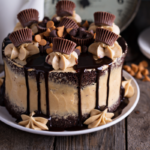Description
This Chocolate Peanut Butter Cake recipe is a decadent delight, perfectly blending the rich, deep flavors of chocolate with the creamy, nutty taste of peanut butter. Featuring moist chocolate layers, a smooth and fluffy peanut butter frosting, and an optional glossy chocolate ganache topping, this cake is a dream come true for chocolate and peanut butter lovers. It’s an ideal choice for special occasions or as a luxurious treat for any day. Follow the simple steps and expert tips to create a bakery-quality cake that’s sure to impress!
Ingredients
Scale
Ingredients
For the Chocolate Cake:
- 1 and 3/4 cups (220g) all-purpose flour
- 3/4 cup (75g) cocoa powder
- 2 cups (400g) granulated sugar
- 1 and 1/2 teaspoons baking powder
- 1 and 1/2 teaspoons baking soda
- 1 teaspoon salt
- 2 large eggs
- 1 cup (240ml) buttermilk
- 1/2 cup (120ml) vegetable oil
- 2 teaspoons vanilla extract
- 1 cup (240ml) boiling water
For the Peanut Butter Frosting:
- 1 cup (240g) unsalted butter, softened
- 1 cup (250g) creamy peanut butter
- 4 cups (480g) confectioners’ sugar
- 1/3 cup (80ml) heavy cream
- 1 teaspoon vanilla extract
For the Chocolate Ganache (optional):
- 1/2 cup (120ml) heavy cream
- 8 ounces (225g) semi-sweet chocolate, chopped
Instructions
Baking the Cake:
- Preheat Oven: Preheat your oven to 350°F (175°C). Grease and flour two 9-inch cake pans.
- Mix Dry Ingredients: In a large bowl, whisk together flour, cocoa powder, sugar, baking powder, baking soda, and salt.
- Add Wet Ingredients: Add eggs, buttermilk, vegetable oil, and vanilla extract to the dry ingredients and mix until combined.
- Incorporate Boiling Water: Stir in boiling water (batter will be thin). This ensures a moist cake.
- Bake: Pour the batter into the prepared pans and bake for 30-35 minutes or until a toothpick inserted in the center comes out clean.
- Cool: Remove from the oven and allow to cool for 10 minutes, then remove from pans and cool completely on a wire rack.
Making the Frosting:
- Cream Butter and Peanut Butter: In a large bowl, beat the butter and peanut butter together until smooth and creamy.
- Add Confectioners’ Sugar: Gradually add in the confectioners’ sugar, mixing well after each addition.
- Add Cream and Vanilla: Mix in heavy cream and vanilla extract until the frosting is smooth and spreadable.
Assembling the Cake:
- Layer and Frost: Place one cake layer on your serving plate, spread a layer of peanut butter frosting on top. Add the second layer and apply frosting to the top and sides of the cake.
- Chill: Refrigerate the frosted cake for about 30 minutes to set the frosting.
Preparing the Chocolate Ganache (optional):
- Heat Cream: Heat the heavy cream in a small saucepan over medium heat until it begins to gently simmer.
- Make Ganache: Pour the hot cream over the chopped chocolate and let it sit for 2-3 minutes. Stir until smooth.
- Drizzle: Drizzle the ganache over the chilled cake for a decorative finish.
Notes
- Quality Ingredients Matter: For the best flavor, use high-quality cocoa powder and chocolate for the cake and ganache. The type of chocolate you choose can significantly impact the depth of flavor. Similarly, opt for a good quality, creamy peanut butter for the frosting. These ingredients are the stars of your cake, so their quality will shine through in the final product.
- Do Not Overmix the Batter: When combining your wet and dry ingredients, mix just until they are combined. Overmixing the batter can lead to a dense, tough cake because it develops the gluten too much. A light hand ensures a moist and tender crumb.
- Temperature is Key for Frosting: Ensure that the butter and peanut butter are at room temperature before you start making your frosting. This makes it easier to blend them into a smooth, creamy consistency without lumps. If the butter is too cold, the frosting can become clumpy, and if it’s too warm, it may become too runny.
